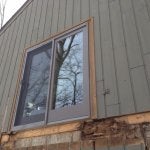Guys got a bad one here. Most are bad in this area but this is beyond bad. What is the game plan and what's involved with fixing this. Who do I call as I this is beyond my skill level.
![]()
![]()
![]()




Correct me if I am wrong, but it appears that the door is not original. Looking at the 1x doubled under the door and the trim detail, this is a replacement. It also appears that the rim joist may be the least of your worries. There may be sub floor damage as well. Jacking almost seems inevitable to make this repair. Agree with minimal jacking just enough to slide out framing and replace as needed. Further investigation may also be needed. If budget allows, pop the door and install proper pan flashing and drip caps.
We make t's out of 2x4's for above the jacks. You can also use jacking lally columns but you need the right length for every job. And we use the jacks for under pinning so there is no reason to purchase more stuff.
x2 have replaced in small sections. with that much rot it isn't carrying much anyway.Quite true. And sometimes it's not that bad, although Barri's looks pretty bad. Every once in a while we are able to replace a small section with no jacking.
